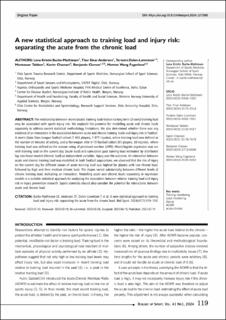| dc.contributor.author | Bache-Mathiesen, Lena Kristin | |
| dc.contributor.author | Andersen, Thor Einar | |
| dc.contributor.author | Dalen-Lorentsen, Torstein | |
| dc.contributor.author | Tabben, Montassar | |
| dc.contributor.author | Chamari, Karim | |
| dc.contributor.author | Clarsen, Benjamin Matthew | |
| dc.contributor.author | Fagerland, Morten | |
| dc.date.accessioned | 2023-10-16T14:24:10Z | |
| dc.date.available | 2023-10-16T14:24:10Z | |
| dc.date.created | 2023-07-31T16:17:12Z | |
| dc.date.issued | 2023 | |
| dc.identifier.citation | Biology of Sport. 2023, 41 (1), 119-134. | en_US |
| dc.identifier.issn | 0860-021X | |
| dc.identifier.uri | https://hdl.handle.net/11250/3096795 | |
| dc.description.abstract | The relationship between recent (acute) training load relative to long-term (chronic) training load may be associated with sports injury risk. We explored the potential for modelling acute and chronic loads separately to address current statistical methodology limitations. We also determined whether there was any evidence of an interaction in the association between acute and chronic training loads and injury risk in football. A men’s Qatar Stars League football cohort (1 465 players, 1 977 injuries), where training load was defined as the number of minutes of activity, and a Norwegian elite U-19 football cohort (81 players, 60 injuries), where training load was defined as the session rating of perceived exertion (sRPE). Mixed logistic regression was run with training load on the current day (acute load) and cumulative past training load estimated by distributed lag non-linear models (chronic load) as independent variables. Injury was the outcome. An interaction between acute and chronic training load was modelled. In both football populations, we observed that the risk of injury on the current day for different values of acute training load was highest for players with low chronic load, followed by high and then medium chronic load. The slopes varied substantially between different levels of chronic training load, indicating an interaction. Modelling acute and chronic loads separately in regression models is a suitable statistical approach for analysing the association between relative training load and injury risk in injury prevention research. Sports scientists should also consider the potential for interactions between acute and chronic load. | en_US |
| dc.language.iso | eng | en_US |
| dc.publisher | Institute of Sport Warsaw | en_US |
| dc.title | A new statistical approach to training load and injury risk: separating the acute from the chronic load | en_US |
| dc.type | Peer reviewed | en_US |
| dc.type | Journal article | en_US |
| dc.description.version | publishedVersion | en_US |
| dc.source.pagenumber | 119-134 | en_US |
| dc.source.volume | 41 | en_US |
| dc.source.journal | Biology of Sport | en_US |
| dc.source.issue | 1 | en_US |
| dc.identifier.doi | 10.5114/biolsport.2024.127388 | |
| dc.identifier.cristin | 2164131 | |
| cristin.ispublished | true | |
| cristin.fulltext | original | |
| cristin.qualitycode | 1 | |
